Nacella macquariensis is a species of true limpet, a marine gastropod mollusc in the family Nacellidae. It is found on the lower foreshore and in the shallow sub-littoral zone of certain islands in the southern Indian Ocean and Southern Ocean.

Dissostichus, the toothfish, is a genus of marine ray-finned fish belonging to the family Nototheniidae, the notothens or cod icefish. These fish are found in the Southern Hemisphere. Toothfish are marketed in the United States as Chilean sea bass or less frequently as white cod. "Chilean sea bass" is a marketing name coined in 1977 by Lee Lantz, a fish wholesaler who wanted a more attractive name for selling the Patagonian toothfish to Americans. In 1994, the U.S. Food and Drug Administration (FDA) accepted "Chilean sea bass" as an "alternative market name" for Patagonian toothfish. The toothfish was remarkably successful in the United States, Europe and Asia, and earned the nickname "white gold" within the market. Toothfish are vital to the ecological structure of Southern Ocean ecosystems. For this reason, on 4 September a national day is dedicated to the toothfish in South Georgia.
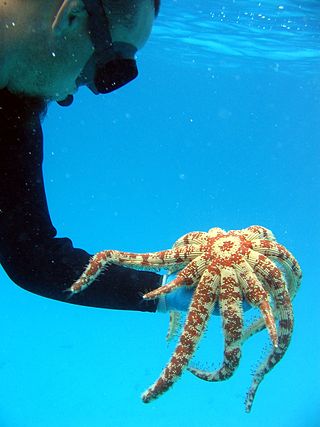
Luidia is a genus of starfish in the family Luidiidae in which it is the only genus. Species of the family have a cosmopolitan distribution.

Odontaster validus is a species of sea star in the family Odontasteridae. Its range includes the Southern Ocean and the seas around the mainland and islands of Antarctica.

Acodontaster is a genus of starfish in the family Odontasteridae. Members of the genus are found in the Southern Ocean, in the waters off Antarctica and the island groups nearby. Acodontaster elongatus is additionally found further north in the Atlantic Ocean on the eastern seaboard of South America.
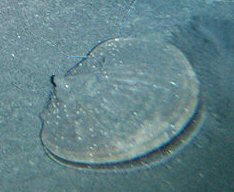
The Antarctic scallop is a species of bivalve mollusc in the large family of scallops, the Pectinidae. It was thought to be the only species in the genus Adamussium until an extinct Pliocene species was described in 2016. Its exact relationship to other members of the Pectinidae is unclear. It is found in the ice-cold seas surrounding Antarctica, sometimes at great depths.

Sterechinus neumayeri, the Antarctic sea urchin, is a species of sea urchin in the family Echinidae. It is found living on the seabed in the waters around Antarctica. It has been used as a model organism in the fields of reproductive biology, embryology, ecology, physiology and toxicology.
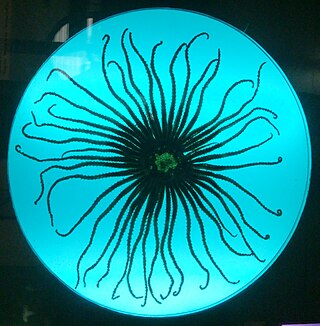
Labidiaster annulatus, the Antarctic sun starfish or wolftrap starfish is a species of starfish in the family Heliasteridae. It is found in the cold waters around Antarctica and has a large number of slender, flexible rays.

The wildlife of Antarctica are extremophiles, having adapted to the dryness, low temperatures, and high exposure common in Antarctica. The extreme weather of the interior contrasts to the relatively mild conditions on the Antarctic Peninsula and the subantarctic islands, which have warmer temperatures and more liquid water. Much of the ocean around the mainland is covered by sea ice. The oceans themselves are a more stable environment for life, both in the water column and on the seabed.

The Freyellidae are a family of deep-sea-dwelling starfish. It is one of two families in the order Brisingida. The majority of species in this family are found in Antarctic waters and near Australia. Other species have been found near New Zealand and the United States.

Paranepanthia is a genus of starfish of the family Asterinidae. Members of the genus have five rays and are found in the waters around Australia, Indonesia and Antarctic New Zealand.
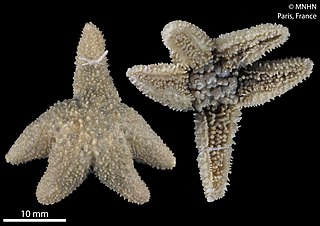
Anasterias is a genus of starfish in the family Asteriidae.

Katrin Linse is a German marine biologist, best known for her work on discovering new Antarctic and deep sea species.
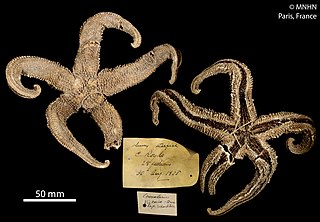
Diplasterias brucei is a species of starfish in the family Asteriidae. It is found in the Pacific Ocean and Southern Ocean. It is a predator and scavenger and is unusual among starfish in that it broods its young.
Urticinopsis antarctica is a species of sea anemone in the family Actiniidae. It is found in the Southern Ocean around Antarctica.
Limatula hodgsoni is a species of bivalve mollusc in the family Limidae, the file shells or file clams. It is native to the seas around Antarctica.

Anasterias antarctica, commonly called the Cinderella starfish, is a species of starfish in the family Asteriidae. It is found in coastal waters in the Southern Ocean and around Antarctica.
Tritoniella is a genus of sea slugs, specifically dendronotid nudibranchs. It is a marine gastropod mollusc in the family Tritoniidae.The genus was described in 1907 by the British diplomat and malacologist Charles Eliot.
Clavularia frankliniana is a species of colonial soft coral in the family Clavulariidae. It is found in the southern Atlantic Ocean and the waters around Antarctica. It was first described in 1902 by the French zoologist Louis Roule.

Labidiaster radiosus, the fragile sticky ray star, is a large species of starfish in the family Heliasteridae and was first described by Lütken in 1871. It is found in the waters of southern South America to Sub-Antarctica and the Antarctic Peninsula.















